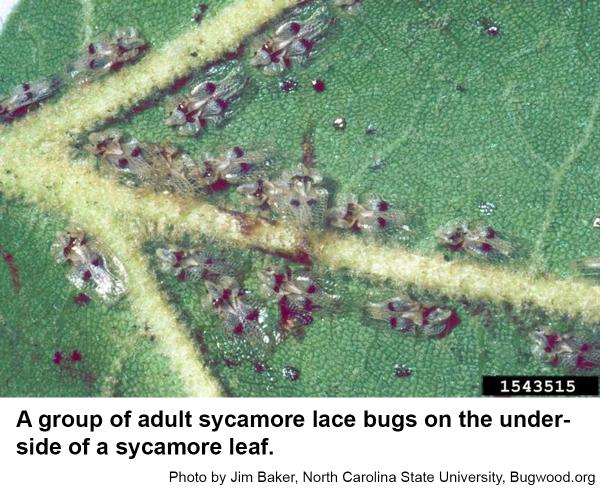Description and Biology
Sycamore lace bugs are small (about 1/8 inch long), white or whitish with a black spot on each wing and on the thorax. This bug is almost rectangular in outline. The sides of the thorax and wings are flattened and covered with veins that give the bug a lacy appearance. Nymphs are smaller, black and spiny. Females emerge in spring and fly to sycamores to lay eggs on the underside of leaves along the leaf veins. Each female can lay up to 350 eggs. Newly hatched nymphs stay close together for the first three molts. After the fourth molt, nymphs may move to new leaves. New adults emerge after the fifth molt. A typical life cycle takes six to eight weeks. Several generations per year occur in the South. Sycamore lace bugs overwinter as adults, either under loose bark of the trees, or in nearby cracks and crevices. Adult sycamore lace bugs are very mobile, are good fliers, and may migrate for a considerable distance when supported by the wind.
Host Plant
Sycamore is the primary host plant of the sycamore lace bug in North Carolina although paper mulberry, shagbark hickory, leatherleaf, and ash trees have also been reported. Sycamore lace bugs feed on the lower leaf surface and cause yellow or pale spots to appear on the upper leaf surface. If much feeding occurs, the leaves may become almost bleached out and may fall prematurely. Lace bugs also leave "fly specks" or excrement on the lower leaf surface.
Residential Recommendations
Sycamore lace bugs are relatively difficult to control especially if the tree is large. The population may resurge later in the season, because of eggs not killed by the first treatment. Later in the growing season, it may be just as well to wait until the next year to treat. Even if every last lace bug is eliminated, the damaged leaves will not improve in appearance. Insecticides can be applied as foliar sprays, trunk injections, and even soil treatments, but these are costly, and efficacy is often marginal because of re-invasion from nearby trees. Most of the time, treating sycamores is unnecessary and unwarranted. Despite the visual impact of severe damage, the impact on tree health by occasional defoliation on otherwise healthy sycamore is minimal.
References
- Lace Bugs, Frank, S. D. and S. Bambara. 2009 (revised). Entomology Insect Notes. NC State Extension Publications.
- Common name: sycamore lace bug, scientific name: Corythucha ciliata (Say) (Insecta: Hemiptera: Tingidae). Halbert, S. E. and J. R. Meeker. 2001. Featured Creatures. Entomology & Nematology, FDACS/DPI, EDIS Publication Number: EENY-190.
- The lace bugs (Hemiptera: Tingidae) of North Carolina and their hosts. Horn, K. F., C. G. Wright, and M. H. Farrier. 1979. North Carolina Agr. Exp. Sta. Tech. Bull. 257. 22 pp.
- Extension Plant Pathology Publications and Factsheets
- Horticultural Science Publications
- North Carolina Agricultural Chemicals Manual
For assistance with a specific problem, contact your local Cooperative Extension Center.
This Factsheet has not been peer reviewed.
Publication date: July 18, 2016
Reviewed/Revised: Oct. 15, 2019
Recommendations for the use of agricultural chemicals are included in this publication as a convenience to the reader. The use of brand names and any mention or listing of commercial products or services in this publication does not imply endorsement by NC State University or N.C. A&T State University nor discrimination against similar products or services not mentioned. Individuals who use agricultural chemicals are responsible for ensuring that the intended use complies with current regulations and conforms to the product label. Be sure to obtain current information about usage regulations and examine a current product label before applying any chemical. For assistance, contact your local N.C. Cooperative Extension county center.
N.C. Cooperative Extension prohibits discrimination and harassment regardless of age, color, disability, family and marital status, gender identity, national origin, political beliefs, race, religion, sex (including pregnancy), sexual orientation and veteran status.



